By Kyle Orton (@KyleWOrton) on January 20, 2017

Muhsin al-Fadhli [top-left]; Abdul al-Sharikh (Sanafi an-Nasr) [bottom-left]; Radwan Nammous (Abu Firas al-Suri) [centre]; David Drugeon [top-right]; Rifai Taha (Abu Yasser al-Masri) [bottom-right]
For two years, the targeting was sporadic, at best, and conducted under a public diplomacy that said those being targeted were part of the “Khorasan Group,” agents of al-Qaeda “central” (AQC) who had migrated to Syria, rather than the paramilitary forces of al-Nusra/JFS. The degree of separation or autonomy between JFS and these AQC operatives, known as Khorasannites, was vastly overstated, however.
Many of the Khorasannites were dispatched into Syria in 2013 at the outbreak of disorders between JFS and its parent branch, the Islamic State (IS), that eventuated in a complete split in February 2014. The Khorasannites then remained in place to keep JFS in al-Qaeda’s camp—to prevent it from “going local”—and some of the Khorasannites formed cells that plotted international terrorism. This was detected in the summer of 2014 and was among the constellation of reasons that led to the initial airstrikes. The plots for external operations were apparently ordered to be stopped in early 2015 by al-Qaeda’s emir, Ayman al-Zawahiri. The integration between the largely-foreign JFS leadership and the rest of the organization has only deepened in this time, and al-Qaeda indeed has broadened its network to include leaders and even sections of other groups, notably Ahrar al-Sham, with which JFS is now engaged in an open struggle after efforts at co-optation have reached their limit.
In September 2016, President Barack Obama gave the order for a wider campaign to be conducted against JFS that targeted its leadership as a whole, rather than just the Qaeda veterans among them. Some strikes were seen in late 2016, but the real effects began to be seen at the beginning of January 2017. To the extent this is a strategy beyond the narrow counter-terrorism goal of eliminating important terrorist operatives, it appears that the U.S. is attempting to tip the balance against JFS in the ongoing negotiations about what JFS calls a “merger”—its effort to co-opt the Syrian revolution so that it can, among other things, fashion a base for international terrorism in Syria that is so integrated with local populations it makes retribution difficult. Such a policy from the U.S. is unlikely to work, and might well backfire.
***
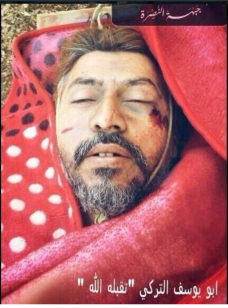
Abu Yusuf al-Turki
September 23, 2014: The first airstrikes by the U.S. into Syria targeted a Jabhat al-Nusra compound and cut down fourteen men: five Turks, including Umit Toprak (Abu Yusuf al-Turki), two Egyptians (one of them Abu Hajar al-Masri), two Yemenis, two Tunisians, a Palestinian, a Serb, and a Russian from the Caucasus. Controversy erupted when it transpired that Toprak was the leader of al-Nusra’s Wolf Unit, leading some to conclude that the Wolf Unit was al-Nusra’s name for what Western officials were calling the Khorasan Group. This was mistaken: the Wolf Unit is a separate entity to the Khorasan Group, a commando-like outfit within al-Nusra that provides specialist military training and was indeed headed by Toprak, himself a legendary sniper. Some of the Khorasannites had been trained by the Wolf Unit.
July 5, 2015: A Coalition airstrike near Aleppo killed David Drugeon, a French national and bomb-maker who was associated with the Khorasan Group and was plotting external attacks, according to the Pentagon. It had been reported that Drugeon was both killed and had been a French spy in late 2014, a story that quickly unravelled.
July 8, 2015: Muhsin al-Fadhli was killed in an airstrike as he travelled in his car near Sarmada, Idlib. Al-Fadhli was “the leader of a network of veteran al-Qaeda operatives, sometimes called the Khorasan Group, who are plotting external attacks against the United States,” according to the Pentagon. The September 2014 airstrikes were thought for a time to have killed al-Fadhli (something that was possibly wilful misinformation). Al-Fadhli was a very senior al-Qaeda member who was possibly involved in U.S.S. Cole attack and seems to have known of the 9/11 attack in advance. Al-Fadhli’s location in the 2000s is not entirely clear. When designated by the U.S. Treasury in February 2005, Fadhli was referred to as a veteran of the Chechen jihad who was “an al-Qaeda leader in the Gulf countries,” suggesting that al-Fadhli, who is a Kuwaiti national, might well have been based in Kuwait at the time. This would tally with reports that it was al-Fadhli who converted Mohammed Emwazi (Abu Muharib al-Muhajir), otherwise known as “Jihadi John,” from Shi’ism to militant Sunnism in Kuwait in 2007. The designation said al-Fadhli was helping support then-al-Qaeda in Mesopotamia (AQM), now IS, in shipping resources, including fighters, into Iraq, often through Iran, from Afghanistan and Pakistan. Al-Fadhli was implicated in the October 2002 attacks against the French ship MV Limburg and the U.S. Marines on Faylaka Island, both operations from Kuwait, and in August 2009 a cell with ties to Fadhli was rolled up in Kuwait as it planned an attack on the U.S. Camp Arifjan. Not long after this al-Fadhli was reported to be in Iran. Treasury sanctions in October 2012 said Fadhli “began working with al-Qaeda’s Iran-based facilitation network in 2009″ [italics added]. This suggests al-Fadhli moved from Kuwait to Iran in late 2009, and would have been in Kuwait in 2007. Al-Fadhli was “arrested” by the Iranians in 2009, and whatever minimal restrictions that entailed were lifted in 2011 to allow al-Fadhli to take over leadership of the Iran-based Qaeda network when the flagrancy of Tehran’s assistance to al-Qaeda became too much and they had to lock Yasin al-Suri up for a bit; they soon released him and he took back over from al-Fadhli, who moved shortly afterward to Syria. Al-Qaeda’s Iranian network still exists and funnels resources to al-Nusra in Syria.
August 12, 2015: A Dutch military leader of Jabhat al-Nusra, Abu Muhammad al-Hollandi, was killed (H/T Pieter van Ostaeyen) Abu Muhammad was a high-profile figure for al-Nusra—active on social media, for example. Abu Muhammad was reported by al-Nusra to have been killed by an airstrike on his car, which also killed three other al-Nusra jihadists, as Abu Muhammad carried out reconnaissance in southern Aleppo Province.
October 15, 2015: Abdul Muhsin al-Sharikh (Sanafi an-Nasr), a long-time al-Qaeda agent from Saudi Arabia who entered Syria in 2013 to mediate between al-Nusra and IS, was killed in Idlib, according to the U.S. Defence Department. A third cousin of Usama bin Ladin, al-Sharikh became a leading propagandist-recruiter around 2006 and was one of the most wanted men in Saudi Arabia as of 2009. Al-Sharikh had served as the head of the facilitation network al-Qaeda operates in Iran with the full permission of the government, and became head of al-Qaeda’s “core finances” in 2012, before he moved to Syria. By the time al-Sharikh arrived in Syria, he was the head of al-Qaeda’s Victory Committee, which develops and implements strategy. Once in Syria, al-Sharikh “organized and maintained routes for new recruits to travel from Pakistan to Syria through Turkey in addition to helping al-Qaeda’s external operations in the West,” according to the Pentagon. Believed to have been killed in March 2014 during the insurgent offensive in Latakia, this was dispelled when the U.S. Treasury levied sanctions against al-Sharikh five months later.
April 3, 2016: An American airstrike in Idlib killed Radwan Nammous (Abu Firas al-Suri), his son, and twenty other Jabhat al-Nusra and Jund al-Aqsa jihadists. Nammous fled Syria when the Islamist revolt was crushed at Hama in 1982, went to Afghanistan where he linked up with Usama bin Ladin, fled Afghanistan after 9/11, and came full circle in 2013, returning to Syria initially as part of al-Qaeda’s mediation efforts between al-Nusra and IS and staying on to aid al-Qaeda’s project. Nammous had worked with Usama bin Ladin and other al-Qaeda founders “to train terrorists and conduct attacks globally” during the 1980s-90s. When he was killed Nammous was a very senior religious official and de facto spokesman for al-Nusra. Other al-Nusra jihadists killed were: Abu Sumayyah al-Khorasani, Hamza al-Faransi, Abu Yusuf al-Turki, and Abdel Muhsin al-Sharikh. A member of Jund al-Aqsa’s shura council, Nasr al-Filistini, was also killed. Initially it was misreported that Samir Hijazi (Abu Hammam al-Suri), al-Nusra’s military leader, was among the dead. Hijazi would later re-appear on 23 August 2016 when he joined with Iyad al-Tubaysi (Abu Julaybib) and Bilal Khuraysat (Abu Khadija al-Urduni) in publicly separating from JFS because of its ostensible dissociation from al-Qaeda.
April 5, 2016: Rifai Taha (Abu Yasser al-Masri) was killed in a U.S. airstrike in Idlib that was probably intended for Ahmad Mabruk (Abu Faraj al-Masri). Taha is a co-founder of al-Gamaa al-Islamiyya, which he has led after 1993 when Umar Abdel-Rahman (“The Blind Sheikh”) was arrested for his role in the first World Trade Centre bombing. Taha was also wanted over the attempted assassination of Egypt’s then-ruler Hosni Mubarak in 1995 and the Luxor massacre in 1997. Taha was freed in Egypt after the revolution that felled Mubarak in 2011 and fled the country after the violent military coup in July 2013, taking residence in Turkey with a number of other senior al-Qaeda-linked officials, notably Muhammad al-Islambuli; both Taha and al-Islambuli were associated by Western officials with the “Khorasan Group”. (Khalid al-Islambuli, Muhammad’s brother, was the murderer of Anwar al-Sadat.) Taha was working to mediate between the leadership circles of al-Nusra and also to try to secure al-Nusra’s merger with Ahrar al-Sham at the time he was killed.[1] Abu Umar al-Masri was killed alongside Taha. Abu Umar was the right-hand man to Thamir Saleh Abdullah (Emir Khattab), during the Chechen jihad, and travelled to Syria along with Murad Margoshvili (Muslem al-Shishani), Sayfullah, and Salaheddin.
May 13, 2016: An airstrike, very likely by the U.S., on al-Nusra-controlled Abu al-Duhour airbase in Idlib Province killed sixteen senior al-Nusra jihadists, notably Abu Hajar al-Urdani and Abu Dawud al-Baljiki. Also among the dead were allegedly: Abu Nasser al-Idari, Abu Trab al-Hamoi, and Abu Shemaa. Abu al-Duhour was captured by the insurgency in September 2015, essentially the final position held by the Assad regime in Idlib Province, providing one of the immediate triggers for the direct Russian intervention. According to some sources on the ground, the strike narrowly missed al-Nusra’s leader Ahmad al-Shara (Abu Muhammad al-Jolani), his deputy and chief shar’i Sami al-Uraydi, Ahmad Mabruk (Abu Faraj al-Masri), and the rest of the Shura Council, who had left about half-hour before. If that is true and Abu Dawud was indeed a military official, his presence at this time after such a meeting suggests he had a very important security role in the organization.
STRIKES SINCE THE U.S. DECISION TO ESCALATE AGAINST AL-QAEDA
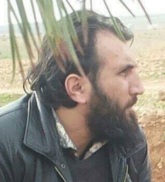
Usama Nammoura (Abu Umar al-Saraqib)
September 8, 2016: Usama Nammoura (Abu Umar al-Saraqib), the JFS military official leading the Jaysh al-Fatah coalition as it tried to break the pro-Assad coalition’s siege of Aleppo City, was killed
October 3, 2016: Ahmad Salama Mabruk (Abu Faraj al-Masri), one of al-Qaeda’s longest-serving and most important operatives, was killed. Mabruk had tried for Islamist revolution in his native Egypt and gone into exile when that failed. Mabruk had served al-Qaeda in Azerbaijan, the rear-base for the jihad in Chechnya, and it was in Baku that Mabruk was rounded up by the CIA in 1998 in possession of a laptop described as “the Rosetta Stone of al-Qaeda”. One of the first terrorists subject to the rendition program, Mabruk was sent back to Egypt, where he remained in jail until 2012. Mabruk fled—in a similar way to (and perhaps in the company of) Rifai Taha and Muhammad al-Islambuli—after the elected government was liquidated in Egypt in July 2013 and the new regime began massacring those who protested about it. Mabruk was seated at the right hand of Ahmad al-Shara (Abu Muhammad al-Jolani) when he rebranded al-Nusra to JFS in July 2016.
October 17, 2016: The U.S. killed Haydar Kirkan in Idlib, confirmed by the Pentagon on 2 November. Kirkan, a Turkish citizen, was a “long-serving and experienced facilitator and courier” for al-Qaeda, the U.S. Defence Department added, who had “ties” to Usama bin Ladin and other senior al-Qaeda members. The Pentagon went on to explain that Kirkan was al-Qaeda’s “senior external terror attack planner in Syria, Turkey, and Europe”. The Pentagon spokesman, Navy Captain Jeff Davis, noted that about a year ago al-Qaeda “core” fighters had begun arriving in Syria, quite possibly a reference to those freed by Iran. These new arrivals have set up a shura, an executive council, says Davis, which is “focused on external operations” and found a “friendly, hospitable environment with [Jabhat] al-Nusra”. Al-Nusra has formally distanced itself from foreign terrorism, though it seems to have dabbled at various points. A leaked U.S. State Department cable reports on a series of raids in Istanbul, Kocaeli, and Izmir in western Turkey by the authorities in late January 2007 related to Kirkan. The “Kirkan Group” was linked to the two bombings in Istanbul in November 2003, the cable said, and was “in preparation for a big scale terrorist act in Turkey” when it was rounded up. Materials related to Osman Karahan, a lawyer who had defended al-Qaeda suspects and been arrested in December 2006, were found in Kirkan’s house, the cable documented. (Karahan was released for lack of evidence and then killed on jihad in Syria in August 2012.)

Abu Abdallah al-Muhajir (or Abu Afghan al-Masri)
November 18, 2016: The U.S. struck down Abu Abdallah al-Muhajir, misidentified at the time as Muhammad al-Saghir, a key ideological founder of IS, who also uses that kunya. The departed Abu Abdullah was also known as Abu Afghan al-Masri.
November 2, 2016: American airstrikes in Idlib killed two JFS officials, soon named as Ala’a Ayoub and Mustafa Zaytir.

Abu Umar al-Turkistani
January 1, 2017: A U.S. drone-strike killed at least eight Qaedaists in a convoy as it left Sarmada, not far from the Turkish border in Idlib Province. Muslah al-Alyani, a close associate of Abdallah al-Muhaysini, a Saudi JFS official who claims to be independent of all factions, was initially misreported as among the slain. Those killed included Abu Umar al-Turkistani, a Uyghur (Chinese Muslim), who was trying to help al-Qaeda co-opt the insurgency in northern Syrian. [UPDATE: Most reports initially assumed, because of his ethnicity, that Abu Umar was a senior leader of the JFS-dependent, Uyghur-majority Turkistan Islamic Party. A fuller profile of Abu Umar, released in February 2017, disclosed that he was the military emir of Ansar Jihad, a small foreign fighter unit within the JFS tent composed of jihadists from Turkey and former Soviet Central Asia. Abu Umar had allegedly travelled from the Muslim-majority Xinjiang Province in China to Taliban-held areas of Afghanistan before the onset of Operation ENDURING FREEDOM and was involved in the last stand of the Taliban-Qaeda regime at Tora Bora. Slipping into Pakistan, Abu Umar was reportedly arrested and spent a decade in Islamabad’s prisons, before going straight back to the jihad in Afghanistan upon release. Able to speak Russian, Abu Umar rose to a senior post in the Islamic Jihad Union (IJU), which broke away from the Islamic Movement of Uzbekistan (IMU) in 2002. Both IJU and IMU were primarily ethnic-Uzbek organisations. In the summer of 2015, IMU dissolved itself by pledging allegiance to IS, becoming part of Wilayat Khorasan, and around the same time Abu Umar made his move to the Levant.] Additionally, the strike killed Abu Khattab al-Qahtani, said to be a veteran of the jihad in Afghanistan against the Soviets and of al-Qaeda in the Arabian Peninsula (AQAP), and Abu Mutassim al-Deiri, a Syrian from Deir Ezzor.
January 3, 2017: The U.S. bombed JFS headquarters in Sarmada and the adjacent shari’a court and prison complex. The Pentagon clarified some initially-confusing reports forty-eight hours later, saying that the U.S. “struck the headquarters compound itself, including multiple vehicles and structures. Al-Qaeda’s foreign terrorist fighter network used this headquarters as a gathering place, and their leaders directed terrorist operations out of this location. Although we’re still assessing the results of these strikes, our initial assessment is that these strikes … killed more than 15 al-Qaeda militants and destroyed six vehicles and nine structures on Jan. 3.”
January 6, 2017: Coalition airstrikes in Taftanaz, Idlib, killed Yunus Shuayb (Abu Hassan al-Taftanaz), a JFS Shura Council member, his fifteen-year-old son, and JFS shar’i Muhammad Kamal Shuayb.[2]
January 7, 2017: Another JFS commander was killed—possibly not by the Coalition this time. Abu Yusef al-Ansari was reportedly killed with an explosive device placed in or around his car, rather than by an airstrike.
January 11, 2017: Coalition airstrikes near Saraqib destroyed a car(s) and three motorcycles in two separate strikes, killing JFS officials Abu Ikrama al-Tunisi (a Tunisian), Abu Anas al-Masri (an Egyptian), and between six and ten additional fighters. Suggestive of the political impact these strikes are having, a prominent pro-al-Qaeda outlet responded to these strikes by saying: “The more Jabhat Fatah al-Sham strives to unite the factions…, the more the U.S. airstrikes are increased against them, because it is not ISIS or al-Qaeda or any other organization that the enemies of the umma (Muslim community) really fear; what they really fear is the unity of the Muslims, because this equals strength.” Al-Qaeda can potentially turn the tables on groups resisting a merger. JFS claims to have made a major “sacrifice” in dropping its al-Qaeda links and its elimination—without replacing its capacities in the insurgency (which the U.S. shows no sign of doing)—would weaken the Syrian opposition, so JFS can accuse groups that do not defend it of not serving the best cause of the revolution.[3]
January 12, 2017: Early in the morning, around 2 AM, on the road between Salqin and Kafar Tahareim in Idlib, the Coalition destroyed a car and killed five JFS members, three of them Tunisians: Abu Umar al-Tunisi, Abu Anas al-Tunisi, Abu Hafs al-Tunisi, Khattab al-Shaa’iti, and Abu al-Walid al-Hamawi.
January 12, 2017: At around 3 PM (Syrian time), the Coalition killed Abd al-Jalil al-Muslimi (Abu Ali al-Tunisi), an al-Qaeda veteran in JFS’s ranks, in a precision strike in Saraqib, Idlib. Al-Muslimi “was trained by the Taliban in the late 1990s, when he facilitated extremist travel for the terror group,” according to the Pentagon, and “had extensive and long-standing ties to numerous al-Qaeda external operations planners and terrorists.”
January 17, 2017: Strikes by the Coalition in Aqrabat, between Atma and Bab al-Hawa near the Turkish border in northern Idlib, killed at least one JFS commander, Muhammad Habib Boussadoun al-Tunisi (Abu Ibrahim al-Tunisi). Boussadoun was “an al-Qaeda external operations leader” and facilitator “connected to terrorist plots to attack Western targets,” according to the Pentagon. Boussadoun “arrived in Syria in 2014 after spending several years in countries across Europe and the Middle East, where he maintained ties with multiple extremists.” It is likely more JFS members were killed, given that further strikes allegedly hit Binnish and Taftanaz, and some reports suggested that an Ahrar al-Sham commander had been at least injured. The interest here is two-fold: that Ahrar was in the vicinity of JFS operatives assessed to be engaged in external operations and this Ahrar member was allegedly a Tunisian. Ahrar has always taken foreign fighters but in smaller numbers than JFS and it keeps them out of the spotlight, presenting itself as part of the Syrian mainstream opposition.
January 19, 2017: In the evening, reports emerged that the Coalition had—with a B-52—struck at a JFS training camp in west Aleppo Province, known as Shaykh Sulayman, built on what was previously the regime’s Base 111. Members of Harakat Nooradeen al-Zengi were also present. At least three al-Zengi fighters were killed, as were at least twenty-five JFS members, with other estimates ranging between sixty and one-hundred. The U.S. Department of Defence confirmed the strike the next day and said “[m]ore than 100 al-Qaeda fighters were killed”. Interestingly, the Pentagon added that the airstrike “discourages hardline Islamist and Syrian opposition groups from joining or cooperating with al-Qaeda on the battlefield,” a seeming confirmation that the U.S. is thinking more broadly than counter-terrorism and operating under the belief that this wave of airstrikes can convince Syrian insurgents to decouple from JFS.[4]
January 21, 2017: In the late evening, a suspected U.S. airstrike was conducted against a JFS commander in Sarmada, Idlib.
January 22, 2017: Around midday, a U.S. drone strike in Aqraba killed a JFS leader. Initial reports named him as Abu Musab al-Jazrawi (a Saudi); later claims suggested his name was Abu Musab al-Jazaairi (an Algerian).
January 26, 2017: An airstrike, likely from the Coalition, killed Rabah Tahir, a JFS commander, in his car in Atma, northern Idlib, near the Turkish border.
February 1, 2017: Pictures have circulated claiming to show the Carlton Hotel in Idlib, a base of the Red Crescent, after it has been hit an airstrike. It is unclear whether the Coalition or the pro-Assad coalition conducted the strike and who, if anyone, was killed.
February 3, 2017: Near Sarmada, a Coalition airstrike on a base belonging to JFS—now rebranded Hay’at Tahrir al-Sham (HTS)—killed twelve jihadists, including Ibrahim al-Rihaal Abu Bakr, a Syrian from a village near Taftanaz, also in Idlib Province. Bizarrely, when the Coalition acknowledged the airstrike, it claimed to have struck an Islamic State target—the fifth time this misidentification has occurred since October 2016.
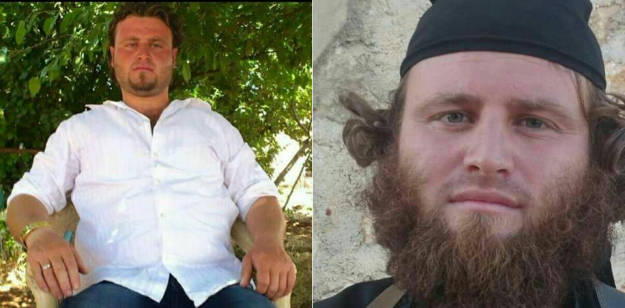
Ibrahim al-Rihaal Abu Bakr
February 4, 2017: Local sources report that a Coalition airstrike killed Abu Hani al-Masri, an Ahrar al-Sham military commander, west of Aleppo. Abu Hani was, according to a Syrian refugee in Turkey who has contacts within Ahrar, a 65-year-old, high-profile jihadi, who had been imprisoned in his native Egypt before going into exile and fighting the jihad against the Soviets in Afghanistan, plus at least two other regional jihads, in Somalia and Chechnya. Abu Hani was also allegedly close to the original leadership of Ahrar, which was wiped out in a mysterious explosion in September 2014. There is some suggestion that Abu Hani, who was also apparently known as Hani Haykal, was on his way to join HTS.
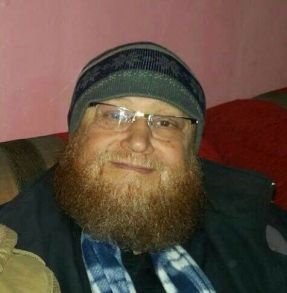
Abu Hani al-Masri
HTS responded to this by trying to claim that the airstrike showed the futility of eschewing contact with al-Qaeda in a merger because here was a group that had refused a merger with al-Qaeda having one of its operatives killed anyway; Muslims and mujahideen in general at the targets said HTS. The statement from Muslah al-Alyani, who joined HTS quickly, said: “We heard a lot of fear [from rebel groups] of terrorist designation … [The rebel groups] said: ‘We will not merge with [Jabhat] al-Nusra because it is al-Qaeda’. So al-Nusra left al-Qaeda. Then they said, ‘We will not merge with [Jabhat] Fatah al-Sham because it is designated’. So Fatah al-Sham entered the merger [that formed HTS]. They then said, ‘We will not enter Tahrir al-Sham because it contains those who are designated’. And today, one of the men of Ahrar al-Sham is bombed, Shaykh Abu Hani (may God accept him). And this is the message to all the factions: as long as you are on the field of jihad and in the field of Islam, then you are designated.”
When the Pentagon acknowledged killing Abu Hani on 8 February, it rather complicated this jihadi narrative by identifying Abu Hani as “a legacy al-Qaeda terrorist with ties to the group’s senior leaders, including Ayman al-Zawahiri and Usama bin Ladin”. The Pentagon says Abu Hani had run terrorist training camps in Afghanistan for al-Qaeda in Afghanistan “in the 1980s and ‘90s, where he recruited, indoctrinated, trained and equipped thousands of terrorists who subsequently spread throughout the region and the world”. Abu Hani was a “founder” of Egyptian Islamic Jihad (EIJ), according to the Pentagon, and in 1998 was part of an EIJ plan to blow up the American Embassy in Albania.
The presence within Ahrar al-Sham’s leadership of men like Abu Hani, and more infamously Muhammad al-Bahaya (Abu Khalid al-Suri), who have historic links to al-Qaeda where they are not identified al-Qaeda agents, gets into a thorny question of what Ahrar actually is. Posts on that broader subject can be found here and here.

Abu al-Khayr
February 26, 2017: Al-Qaeda’s overall deputy, Abdullah Muhammad Rajab Abd al-Rahman, better-known as Abu al-Khayr al-Masri, was killed by a Coalition airstrike in al-Mastuma, Idlib. Abu al-Khayr, an Egyptian, was head of al-Qaeda’s Shura Council when he fled Taliban Afghanistan as the regime collapsed and took up residence in Iran with the founder of the Islamic State, Ahmad al-Khalayleh (Abu Musab al-Zarqawi), among others. Apparently arrested by the Iranian authorities and held in murky conditions—”house arrest” in the Islamic Republic can include al-Qaeda’s officials being able to coordinate bombings as far away as Riyadh and Casablanca—Abu al-Khayr was released in March 2015, along with four other senior al-Qaeda operatives. Once free, Abu al-Khayr was quickly dispatched to Syria, where he oversaw al-Qaeda’s branch, Jabhat al-Nusra. When al-Nusra ostensibly dissociated from al-Qaeda, rebranding itself Jabhat Fatah al-Sham (JFS) in the summer of 2016 in an attempt to better integrate with the Syrian revolution, Abu al-Khayr gave pre-approval for the decision. That said, Abu al-Khayr did not join JFS and when JFS restructured itself into Hay’at Tahrir al-Sham (HTS), Abu al-Khayr did not join that group either. Instead, Abu al-Khayr led a faction—with Iyad al-Tubaysi (Abu Julaybib), who is now under American sanctions, Samir Hijazi (Abu Hammam al-Suri), Bilal Khuraysat (Abu Khadija al-Urduni), and a half-dozen other ultra-extremists—that retained a public allegiance to al-Qaeda. This was the role Abu al-Khayr held, as well as directing regional affiliates—not unlike Nasser al-Wuhayshi (Abu Basir), the al-Qaeda in the Arabian Peninsula (AQAP) emir who was also al-Qaeda’s General Manager—when he was struck down. (The weapon used to destroy Abu al-Khayr is also its own interesting story.)
March 16, 2017: Just after 19:00, an airstrike hit the Umar ibn al-Khattab Mosque, near the village of Al-Jinah in western Aleppo province. CENTCOM announced on this day—without specifying the location—that it had attacked an Al-Qaeda “meeting location … in Idlib”, an error because Al-Jinah is so close to the provincial border, as CENCTOM soon confirmed. CENTCOM was also in error that jihadists were meeting: it was prayer-time and thirty-eight or more civilians were killed. [It is noticeable that—with two exceptions that were almost certainly pre-loaded on the target list—the anti-Qaeda strikes in north-west Syria stopped for twenty-seven months after this.]
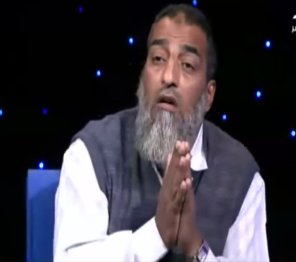
Abu al-Alaa Abdrabu
March 21, 2017: A U.S. airstrike killed Abu al-Alaa Abdrabu, an Egyptian former member of al-Jamaa al-Islamiyya prosecuted for numerous terrorism offences in his homeland, including involvement in the murder of Farag Foda, a notable secularist, in June 1992. There are competing accounts of how Abdrabu got to Syria and what he was doing there: by one account, Abdrabu was released from prison in Egypt during the period of military rule in 2011 and joined Hay’at Tahrir al-Sham; by another account, Abdrabu was released in Egypt after the Muslim Brotherhood government was elected in 2012 and joined the Islamic State initially in Syria, before switching to Ahrar al-Sham.

Abu Jabber al-Hamawi
March 27, 2017: Local sources claim a Coalition drone strike has hit a car on the road between Sarmada and Kafr Dariyan in Idlib Province. The Coalition previously struck this area on 3 January. Initial reports suggest six people have been killed. One of the slain is a Hay’at Tahrir al-Sham (HTS) judge from Marat al-Numan, Abu Jabber al-Hamawi. It is claimed by the jihadists that Abu Jabber was on his way to the front in Hama, where the insurgency is assaulting Qomhana, the northern gateway to Hama City. Al-Qaeda (HTS) is spinning this as the U.S.-led Coalition assisting the forces—Russia and Iran predominantly—propping up the regime of Bashar al-Assad.
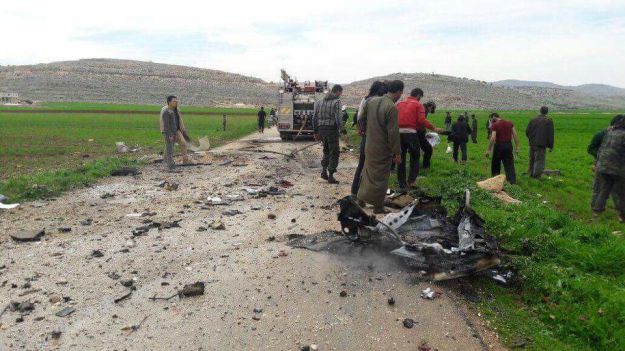
Aftermath of U.S. drone strike near Sarmada on 27 March 2017 (source)
A ONE-OFF STRIKE?
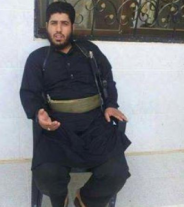
Iyad al-Tubaysi (Abu Julaybib)
December 29, 2018: In Deraa in southern Syria, Iyad Nazmi Salih Khalil (Iyad al-Tubaysi or Abu Julaybib) was killed alongside two other Al-Qaeda jihadists in circumstances that are distinctly unclear, with reports ranging from a drone strike to clashes near the border as he tried to cross into Jordan. The post-mortem photograph does little to clear up how Al-Tubaysi died, though it is quite possible that the weapon used nearly two years ago in Idlib to kill Al-Qaeda’s deputy was responsible.
INTERMITTENT STRIKES RESUME
June 30, 2019: The U.S. launched an airstrike against what CENCTOM described as “Al-Qaida in Syria (AQ-S)”, presumably Tanzim Hurras al-Deen, targeting its “leadership at a training facility near Aleppo Province”. These jihadists were “responsible for plotting external attacks threatening U.S. citizens, our partners, and innocent civilians”, according to CENTCOM, which did not specify the identities of the people killed, nor even the number of people killed. It was claimed by SOHR, which is notoriously unreliable, that of the six Hurras commanders killed, two of them were Tunisian, two were Algerian, one was Egyptian, and one was Syrian.
August 31, 2019: The U.S. launched an airstrike “north of Idlib” against the “leadership” of “Al-Qaeda in Syria (AQ-S)” [Hurras al-Deen], according to CENTCOM’s vague statement. The CENTCOM statement went on to say that “the removal of this facility will further degrade [Al-Qaeda’s] ability to conduct future attacks and destabilize the region”, adding that AQ-S/Hurras retains “a safe haven” in north-west Syria where it “actively coordinate[s] terrorist activities throughout the region and in the West”.
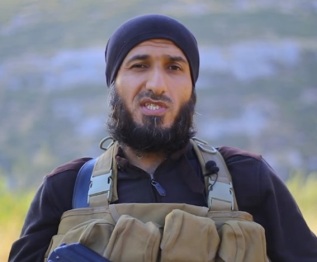
Bilal Khuraysat (Abu Khadija al-Urduni) [image source]
June 14, 2020: A U.S. drone strike in Idlib killed Khaled al-Aruri (Abu al-Qassam al-Urduni), a Jordanian who was the military commander or general military official of Al-Qaeda’s overt presence in Syria, Tanzim Hurras al-Deen. Killed alongside Al-Aruri was a Yemeni citizen, the commander of Jaysh al-Badiya (The Desert Army) unit of Hurras, Bilal al-Sanani. From the video footage available, it appears Al-Aruri and Al-Sanani were killed while travelling in a car, and a reasonable guess can be made that they were killed with the “ninja bomb” or “flying Ginsu”, more formally the R9X variant of a Hellfire missile, which as The Wall Street Journal reported last year “carries an inert warhead … designed to plunge more than 100 pounds of metal through the tops of cars and buildings to kill its target without harming individuals and property close by.” The Journal added that the R9X payload includes “six long blades that … deploy through the skin of the missile seconds before impact to ensure that it shreds anything in its tracks.” One of these blades can be seen in the footage. Hurras put out a statement on Al-Aruri’s “martyrdom” ten days later.
Al-Aruri’s demise is significant in a number of ways. A longstanding jihadist, Al-Aruri was the deputy to and brother-in-law of the Islamic State founder, Ahmad al-Khalayleh, better known as Abu Musab al-Zarqawi. (See Tore Hamming’s profile of Al-Aruri for more details.) Al-Aruri came to Syria in 2015 after the clerical regime in Iran “released” five Al-Qaeda members. Two of them, Muhammad Saladin Zaydan (Sayf al-Adel) and Abdullah Ahmed Abdullah (Abu Muhammad al-Masri), stayed in Iran—one of many bizarre facts about the circumstances under which these men were “detained”. The other two came to Syria with Al-Aruri and both have already been killed. Al-Qaeda’s deputy, Abu al-Khayr, was killed in February 2017 in one of the first known uses of the R9X, and Sari Shihab (Abu Khaled al-Muhandis) was killed in August 2019.[6]
August 13, 2020: A drone strike, presumably from the U.S. and it seems using the R9X missile, has killed a jihadist “military trainer” in Idlib, named on militant forums as Abu Yahya al-Uzbeki, who was probably a member of Hurras al-Deen, though there are claims he was independent.
September 14, 2020: A senior Hurras al-Deen operative, Sayyaf al-Tunisi, and an associate, Safina al-Tunisi, were killed by a U.S. drone strike while they were driving near the Ruwda mosque in the Qusur district in middle of Idlib city. The ability of the U.S. to carry this off without endangering civilians was because they once again used the R9X “Ninja” Hellfire missile. Safina is said to have been involved, as a then-member of Jabhat al-Nusra, in the massacre of nearly two-dozen Druze and their forced conversions in the Qalb Lawze area of Jabal al-Summaq in June 2015.
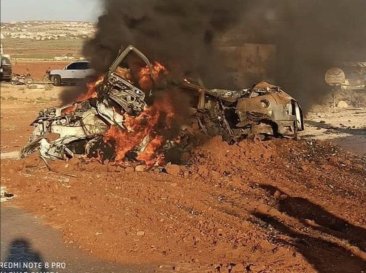
Alleged remnants of the car in which Abu Dhar and Abu Yusef were killed
October 15, 2020: A drone strike in the village of Arab Sa’id in Idlib province that CENTCOM took credit for is reported to have killed Abu Dhar al-Masri, a former shari’a official with Hurras al-Deen, and Abu Yusef al-Maghribi, Hurras’ former general security official. The pictures circulating on social media indicate that this strike was not done with the R9X Hellfire but a more conventional missile. Though both men had left Hurras al-Deen, they had joined small jihadi groups that remained in Al-Qaeda’s orbit. Abu Dhar was rumoured to have been killed by the 30 June 2019 U.S. strike into Idlib that restarted the current phase of targeted assassinations against Al-Qaeda and its allies in Syria. At that time, it was said Abu Dhar was targeted because he was part of a jihadi cell that was planning “external operations”—attacks on the West outside Syria—and this is why he had been expelled from Hurras and was wanted by HTS.
It was announced nearly two weeks later on jihadist social media channels that this strike had killed Saleh al-Karuri (Abu Muhammad al-Sudani), an Al-Qaeda operative back to the days the group’s establishment in the late 1980s and a senior member of Hurras al-Deen. The delay in reporting Abu Muhammad’s death is conceivably because he was injured in the strike and only died later. Regardless, the real importance of Abu Muhammad’s demise in this strike is underlining how illusory is the “distance” Hurras tried to put between itself and the jihadists regarded as a terrorism threat by America.
October 22, 2020: A U.S. drone strike in the village of Jakara, just outside Saraqeb in east-central Idlib province, killed several Al-Qaeda leaders. CENTCOM was vague on what it hit, but sources in the area indicate that it was a meeting of non-HTS jihadists hosted by Idlib’s criminal kingpins, the brothers Samer Souad and Amer Souad, both of whom were hit in the strike. The jihadist targets struck include: Ibrahim Souad; Abdulqader Tahhan (Abu Bilal Qadas); Hamoud Sahara, one of the founders of Kataib al-Fatah, who was part of the Islamic State movement and ran a kidnapping unit for Jabhat al-Nusra when it was IS’s front group in Syria; Abu Talha al-Hudayda; Abu Hafs al-Urduni; and at least one unidentified member of Hurras al-Deen. Initial reports that the leader of Tansiqiyya Jihad, Abu al-Abed al-Ashida, had been killed proved to be false. Three tribal figures were also killed: Abu Hassan Shash, Hassan Dhibaan, and Ahmad Jarrah.
Because of the very clear benefits HTS derived from this strike, the elimination of what seems to be the entire leadership cadre of Kataib al-Fatah plus the leading figures in the informal economy that form a power centre of their own to rival HTS, there has been much speculation that HTS provided the intelligence for the strike, probably indirectly through Turkey. Since the purpose of the meeting was allegedly to plan anti-regime operations, and HTS is (for now) committed to the ceasefire Turkey made with Russia after the Turks’ drone war against the Asad/Iran system in March, this has added to the qui bono considerations that point to a HTS hand in the strike. Still, there is no concrete evidence for this and given the way the strike program works in Idlib—not to mention the bad blood between Ankara and CENTCOM—this notion is open to doubt.
Later claims suggested that the 15 October and 22 October drone strikes against Al-Qaeda targets in north-west Syria traced back to intelligence captured in Afghanistan when a senior Al-Qaeda official, Husam Abd al-Ra’uf (Abu Muhsin al-Masri), was killed earlier that month, while embedded with the Taliban. It was for this reason, according to Afghan officials, that the announcement of Abd al-Ra’uf’s demise was delayed until 25 October, when he had been killed presumably early in the week beginning 12 October.
September 20, 2021: A U.S. drone strike in Idlib, it seems on a car in Binnish, eliminated two foreign Hurras al-Deen leaders, military commander Abu Hamza al-Yemeni and ideologue Abu al-Bara al-Tunisi. Abu al-Bara, once a senior shar’i and senior administrator in Jabhat al-Nusra, was close to Sami al-Uraydi after he defected to Hurras. Later, it was reported that a third Hurras leader, Salim Abu Ahmad, was in the car that was destroyed. “Salim Abu Ahmad was responsible for planning, funding, and approving trans-regional Al-Qaeda attacks,” according to CENTCOM spokesman Army Major John Rigsbee. CENTCOM was insistent that only the Hurras targets were killed and there were “no indications of civilian casualties” because this strike came three days after the U.S. admitted the error over the 29 August drone attack in Afghanistan.
October 23, 2021: Abdul Hamid al-Matar, a Hurras al-Deen operative who formed part of Al-Qaeda’s capacity to “plot and carry out global attacks”, was announced by the Pentagon to have been killed in an MQ-9 Reaper attack in Syria. Interestingly, the strike that killed Abd al-Hamid was not in Idlib, but in the far north of the Raqqa province on the Syria-Turkey border, in Suluk, one of the towns occupied in the Turkish BARIS PINARI operation in 2019. The Turkey-held areas of Syria have proven to be hospitable territory for jihadists, not only the Qaedaists but the Islamic State.
June 27, 2022: A U.S. MQ-9 Reaper killed Hurras al-Deen commander Abu Hamza al-Yemeni as he rode a motorcycle in open territory in Idlib province. Local reports of drone sightings make clear the U.S. had been tracking Abu Hamza for at least a day before he was killed—and it does seem he is dead this time, having faked his death during the September 2020 drone strike. Abu Hamza arrived in Syria in early 2015 from Yemen—he seems to have been an AQAP official until that point—and led the “Jaysh al-Fateh” coalition, which was dominated by Jabhat al-Nusra and Ahrar al-Sham, when it took over Al-Mastuma in May 2015, during the major insurgent offensive. In 2015, it seems Abu Hamza was formally part of Jund al-Aqsa, a faction of Al-Nusra that later defected to the Islamic State, an ironic turn of events given that Jund had been created within Al-Nusra to ride out the Islamic State challenge in 2013. Abu Hamza left Jund when Ahrar attacked it in 2016, moving into the rebranded Al-Nusra (Jabhat Fatah al-Sham) and quickly defecting after the second rebrand (to HTS), joining Hurras.
May 3, 2023: The U.S. conducted a drone strike in Qorqanya, in Idlib: the claim to have killed a “senior Al-Qaeda leader” was soon thrown into doubt when the dead man was identified by his family as Lotfi Hassan Misto, whom they said had no connections to terrorism. U.S. officials were split over this: the two views represented to The Washington Post by one official, who said, “We are no longer confident we killed a senior AQ official,” and another official, who conceded that the “strike did not kill the original target”, but maintained “we believe the person [killed] to be Al-Qaeda”. A formal inquiry was launched in early June 2023.
***
Notes
[1] [UPDATED] Rifai Taha had appeared to be fulfilling some of the role of Muhammad al-Bahaya (Abu Khalid al-Suri), who was deeply, if not “formally,” connected to al-Qaeda’s network. Al-Bahaya, though a member of Ahrar al-Sham, was anointed in 2013 as Ayman al-Zawahiri’s representative in Syria, with his most immediate task being to mediate between al-Qaeda’s Syrian branch, Jabhat al-Nusra and IS. Under al-Bahaya’s guidance, Ahrar forged a lasting battlefield alliance with al-Nusra. As transpires, while Taha might have performed elements of al-Bahaya’s job—and certainly tried to assist in al-Qaeda’s broader program into bind itself to the local landscape and bring the Syrian insurgency under its direction—al-Qaeda appointed Muhammad Hadi al-Anizi, a Kuwaiti fundraiser and facilitator and the brother of another designated terrorist, Abdullah al-Anizi, as its Levantine representative after al-Bahaya was killed by the Islamic State in February 2014.
[2] The Coalition’s daily reports of airstrikes record the 1 January strikes that killed Abu Umar al-Turkistani, Abu Khattab al-Qahtani, Abu Mutassim al-Deiri, and the others, plus the 6 January strikes that killed Yunus Shuayb (Abu Hassan al-Taftanaz) and Muhammad Kamal Shuayb, but bizarrely both of these sets of strikes are recorded as targeting the Islamic State, which was expelled from Idlib by the Syrian rebellion nearly three years ago.
[3] Jaysh al-Sunna, a non-ideological and localist rebel group, claimed on 13 January 2017 that three of its commanders had been killed in Coalition airstrikes aimed at JFS. The U.S. attacks on non-transnationalist insurgent groups feeds into the jihadi narrative that the West was on Assad’s side all along, and only they can protect people from the regime. Jaysh al-Sunna has been part of the Jaysh al-Fatah coalition, which is dominated by JFS and Ahrar al-Sham, and is likely to have become influenced by those groups, not unlike the pattern with Harakat Nooradeen al-Zengi. Nonetheless, it could be true that the strikes hit Jaysh al-Sunna; it has happened before, in August 2015. Nearly a year before that the Coalition had bombed Ahrar, a thorny issue politically between the U.S. and the Syrian opposition. On the one hand, Ahrar has no stated transnational aims and attacks on it can be interpreted as attacks on the whole opposition. On the other hand, Ahrar has played this bridging role between al-Qaeda and rebellion, attempting to align with both camps, and al-Qaeda operatives (seemingly in the execution phase of an external plot) were at Ahrar’s bases, which was the trigger for the airstrike.
[4] In the aftermath of this, JFS and its supporters became distinctly upset at the lack of condolences sent by other insurgents, believing that it was because these groups feared that they, too, would be targeted by the U.S., a point made by the ostensibly-independent senior JFS religious official Abdallah al-Muhaysini. Jabhat Ansar al-Din, an al-Qaeda-linked group, and Jaysh al-Tawhid in Qunaytra did send condolences, but they were among very few.
[5] Drawing together from analysts like Charles Lister and Aaron Zelin and the United Nations reports, the leadership of Hurras al-Deen can be roughly sketched:
- Khaled al-Aruri (Abu al-Qassam al-Urduni), Jordanian [profile]
- Iyad Nazmi Salih Khalil (Iyad al-Tubaysi or Abu Julaybib), Jordanian [profile]
- Bilal Khuraysat (Abu Khadija al-Urduni), Jordanian
- Samir Hijazi (Abu Hammam al-Suri or Faruq al-Suri), Syrian [profile]
- Sami al-Uraydi (Abu Mahmud al-Shami), Jordanian
- Sari Shihab (Abu Khaled al-Muhandis), Jordanian [backgrounder]
- Faraj Ahmad al-Na’na
- Abu Abdulrahman al-Makki, Saudi
- Abu Abd al-Karim al-Khorasani (or Abu Abd al-Karim al-Masri), Egyptian
[6] When it was announced on 22 August 2019 that Abu Khaled al-Muhandis, another of the core of Jordanian Al-Qaeda loyalists that make up Hurras al-Deen, had been killed in Idlib by an IED against his car, it was suspected that this was the same man as Sari Shihab, but it took a little while to confirm from the jihadi eulogies. Shihab was very close to Al-Aruri, “imprisoned” together in Iran for thirteen years and then working side-by-side in Syria. It is unlikely the U.S. is behind Shihab’s killing; the CIA nor any other U.S. intelligence agency has sufficient reach into Idlib to do what was done. The more obvious candidates are Turkey, which has been waging a steady campaign of assassinations against Al-Qaeda jihadists in Idlib, and the Islamic State, which still has cells and agents in the “Greater Idlib” area.
Pingback: The Coalition Strikes Down Al-Qaeda’s Leaders In Syria – Thinking Syria
Pingback: Jihadi Infighting: Clashes Erupt Between Al-Qaeda in Syria and Ahrar al-Sham | The Syrian Intifada
Pingback: Al-Qaeda Rebrands, Marches on in Syria | The Syrian Intifada
Pingback: Al-Qaeda in Syria Denounces America, Claims to Be the Revolution | The Syrian Intifada
Pingback: Jihadi Clerics Dispute Legitimacy of Hay’at Tahrir al-Sham | The Syrian Intifada
Pingback: Surprised by the Max Blumenthal: Tucker Carlson love-in? You shouldn’t be – The Levantine Narrative
Pingback: As Trump shores up Assad's genocidal regime, America's hard left is cheering him on - Times of News
Pingback: As Trump shores up Assad’s genocidal regime, America’s hard left is cheering him on – Opinion – Israel News | | Arabic Press release - gulfnews
Pingback: Ayman al-Zawahiri Finally Addresses the Problems with Al-Qaeda’s Syrian Branch | The Syrian Intifada
Pingback: A Counterterrorism Policy in Syria That Helps Terrorists | The Syrian Intifada
Pingback: Liberating Raqqa from the Islamic State | The Syrian Intifada
Pingback: Al-Qaeda in Syria Linked to a Terror Plot in the United States | The Syrian Intifada
Pingback: Al-Qaeda’s Deputy Killed in Syria | The Syrian Intifada
Pingback: The Jihad Factor in Bosnia | Kyle Orton's Blog